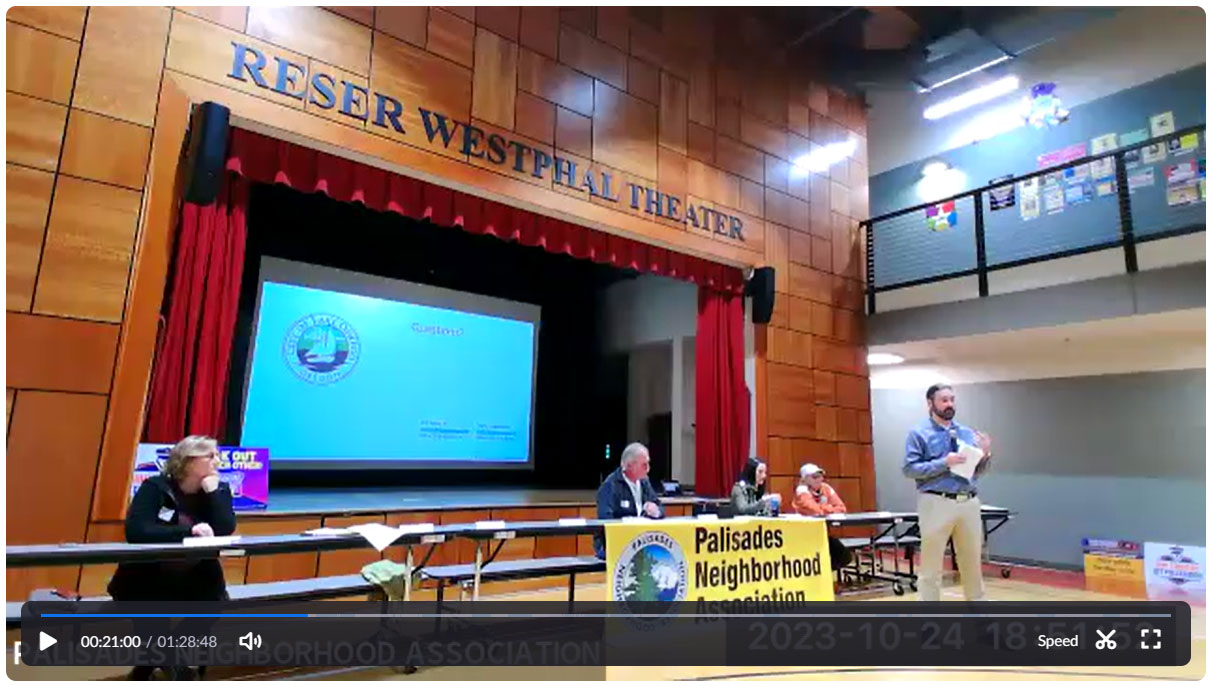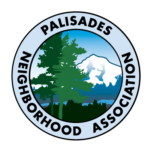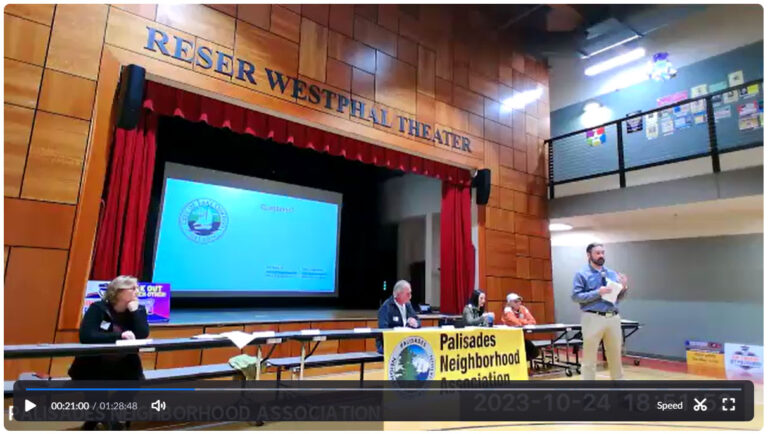Thank you to the Park Academy for their generous use of their facilities and equipment for our General Meeting. Watch the Zoom recording of the Fall General Meeting, Oct. 24, 2023. Passcode: 3=EJFnxS The video will be live for a limited time. Here is a pdf of the slide deck Will Farley, Traffic Engineer, City of L.O. used during the presentation.

10/25/2023 – Submitted by Jenny Cherrytree, PNA Area 4 rep & Member of the PNA Traffic Committee: “Thank you for submitting questions to Traffic Engineer, Will Farley. He answers your questions below and welcomes the community to reach out to him with your solutions and ideas.”
If your question is not answered below please contact William Farley, PE Sr. Assoc. Engineer (Traffic) | Public Works – Engineering, City of Lake Oswego. Direct: 503-635-0274 Email:wfarley@ci.oswego.or.us
#4 Speeding on Fernwood: Speeds were collected on Fernwood back in June of 2022 (prior to school being out). The prevailing speed was reported to be 28 mph, which was in line with the posted speed limit of 25 mph (I included the data in the extra slides of my presentation that I didn’t touch on). Based on the volumes and the speeds, it is unlikely the street would qualify for speed humps through our NTMP program (criteria can be found in our Municipal Code here).
#5 Parking on Atherton and the access to the C-3 Church property: We will be monitoring Atherton for traffic and parking impacts after the park opens up. We are collecting annual counts and will be observing how people use the park (do they all park on site? do they park in the right-of-way?) to see if we need to take corrective action.
For access to the church property north of Rassekh Park, we currently do not see a way for a development to take access from Ridge Pointe Drive and will be expecting it to access Stafford Road.
#6 Lake Oswego School District’s Long-Term Vision: The school district is its own entity, separate from the City, and I do not have access to their plans or vision. I recommend reaching out to the school board and coordinating with them.
#7 Crosswalks at Tree Top Ln / Overlook / Meadowlark: We are holding off on providing striping at this intersection due to the funding of the sidewalk or pathway on Tree Top and Meadowlark. The intersection will be evaluated for pedestrian improvements as part of the Capital Improvement Projects and will likely have some element of redesign that the community will have a say in. Installing the markings prior to the project will increase costs and could influence the design if we have to remove striping shortly after installing it. The Police Department may increase enforcement on this intersection to ensure it remains safe to cross.
#8 Parking on Cloverleaf and School Impacts: Similar to #6 above, I don’t have much influence with the Lake Oswego School District. The City Engineer and I have both sat down with staff at Lakeridge High School to discuss parking strategy, but received push back on any suggestions. I recommend continuing to work with the school on finding solutions to students not parking on the school property.
#9 Speeds on South Shore Blvd and the Speed Limit: We monitor speeds annually on South Shore Blvd and work with Police enforcement. As for the speed limit, the Oregon Department of Transportation control’s the speed limits that can be set on roadways throughout the state and have establish guidelines on how those are set (since speed limits are regulatory). To get a change in the speed limit, an engineering study needs to be conducted to the satisfaction of ODOT that evaluates the context of the roadway and shows that the new speed zone would not lead to most users driving illegally. Based on the data we’ve collected on South Shore, ODOT would not likely approve a reduction of the speed limit.
#10 Additional Signage at Bryant/Lakeview and Near Canal Circle: Adding a No Turn on Red sign creates a new regulation at the intersection that can result in a fine if disobeyed. I’ll need to evaluate the intersection further to ensure the sign can be legally enforceable at that location.
For an additional warning sign for pedestrians near Canal, I’ll need to see what signs are in that location currently. I know there are some warning signs for the corner, so we need to be careful not to over post warning signs, as that would lead to them (and possible others) becoming less effective (too many signs can lead to more becoming background noise).
#11 Over-Engineering Because of Lack of Enforcement: I work closely with our Police Department to make sure any changes to regulatory signs are enforceable without much ambiguity (No Parking signs, Stop signs, and Speed Limit signs are regulatory and need to have solid reasoning to stand up in courts). Over-engineering can lead to further safety issues, as more signs can be less effective (see #10 above) and can lead to disregarding of engineering devices in areas where they are appropriate. Over-engineering with regulatory signs (such as overuse of No Parking signs, improperly posted Speed Limit signs, or unwarranted Stop signs) can lead to legal battles in the court, costing the City more money.
#12 Sidewalk on South Shore Blvd: This project has been identified and is listed in the City’s Transportation System Plan (see Project #88). However, the project is currently unfunded in the City’s Capital Improvement Plan and we would need a significant amount of funding to construct it (it is estimated to cost approximately $10 million). This project has also been included in Metro’s Regional Transportation Plan to be eligible for Federal funding, should it be competitive enough to receive it. Side note: it’s one project I’d love to see get built and I’m watching for grant opportunities to help with it.
#13 Markings on Royce Way Near Westridge Elementary: City operations crews were replacing striping near schools with a more resilient, higher visibility marking. I’m hoping the markings on speed humps and the crosswalk were replaced shortly after this comment came in. If they are still missing, please let me know and I’ll look into why they weren’t reinstalled.
#14 Increased Traffic: Our Transportation System Plan (linked in #12) is the planning document that identifies what improvements are needed in the City to accommodate additional traffic from growth from within the City and throughout the region. As significant development occurs, they are required to evaluate and mitigate any impacts that lead to failing facilities within their land-use applications. Development also is assessed a Transportation Systems Development Charge to help the City construct improvements in other areas of the City, usually identified in the Capital Improvement Plan. Of particular interest, our traffic data shows that overall, volumes on the collectors and arterials around the neighborhood or actually lower than they were in 2015/16 and in some cases lower than before the Great Recession of 2007/08. In general, the traffic volumes in Lake Oswego have not changed much in nearly a decade, partially due to the fact the City is built out and there aren’t major development changes occurring, particularly in neighborhoods like Palisades.
#15 Parking Along Marjorie: Please contact the non-emergency Police number (503-635-0238) to report people parked illegally in the wrong direction or in the signed No Parking areas; however, parking in front of a mailbox is not illegal in the City. You can also contact the staff at Lakeridge High School to let them find the student parking illegally and have them correct the issue.
For the speed hump on Marjorie, based on the location of the street, it is unlikely to have sufficient volumes or speeds to qualify for traffic calming under the Neighborhood Traffic Management Program (see #4 for criteria).”
10/26/2023 Copy of Email between Jon Thies, PNA Area 1 Rep. and Will Farley, PE
Subject: Photo-Radar Enforcement System
“Hi Mr. Thies,
While the establishment of a photo-radar enforcement system would ultimately be up to City Council and the Police Department, I wanted to dig into the requirements myself (my apologies for getting into the technical weeds). If the City was to establish the program, it would be largely overseen by our Police Department with little input from Engineering once established.
Recent legislation (House Bill 2095) amended ORS 810.438 to allow all cities to establish photo-radar enforcement for speeding effective Jan. 2024. With this, Lake Oswego is permitted, at our own cost, to begin using photo radar on residential streets, school zones, or in areas where we can show that speeding has had a negative impact on traffic safety. Please note, since this is regulatory and subject to defending in court, we would need to strictly follow all requirements as well as provide evidence and solid reasoning for any location we deploy such a device.
To establish this program, we would need to purchase and install the equipment in addition to providing all signage (not only at the location, but at all major routes entering the City) to ensure it is legally enforceable. The law then requires that, every biennium, we would need to provide a process and outcome evaluation to the Legislative Assembly. These requirements, in addition to the staff time from the Police Department to issue and defend citations, would likely carry a significant expense to the City. I know that fines can reimburse some of this, but I also know sometimes jurisdictions elect to have a 3rd party assist, which then takes a significant amount of any generated revenue.
If established, per ORS 810.437, citations for speeding can only be issued if a person exceeded the speed limit by 11 mph or greater. While our Police Officers can pull over and cite people now for any amount over the speed limit they deem appropriate, the photo-radar device would have this very specific limit to issue a citation. In my annual review of speeds throughout the City, there are not many residential streets where people regularly exceed the speed limit more than 11 mph (the data shows that most drive 3-5 mph over the speed limit and on occasions upwards of 8 mph).
Since photo radar falls more on the enforcement side, I’m including Sergeant Hall on the email to correct or add anything I may have missed.
Feel free to reach out if you have any further questions or concerns.“


